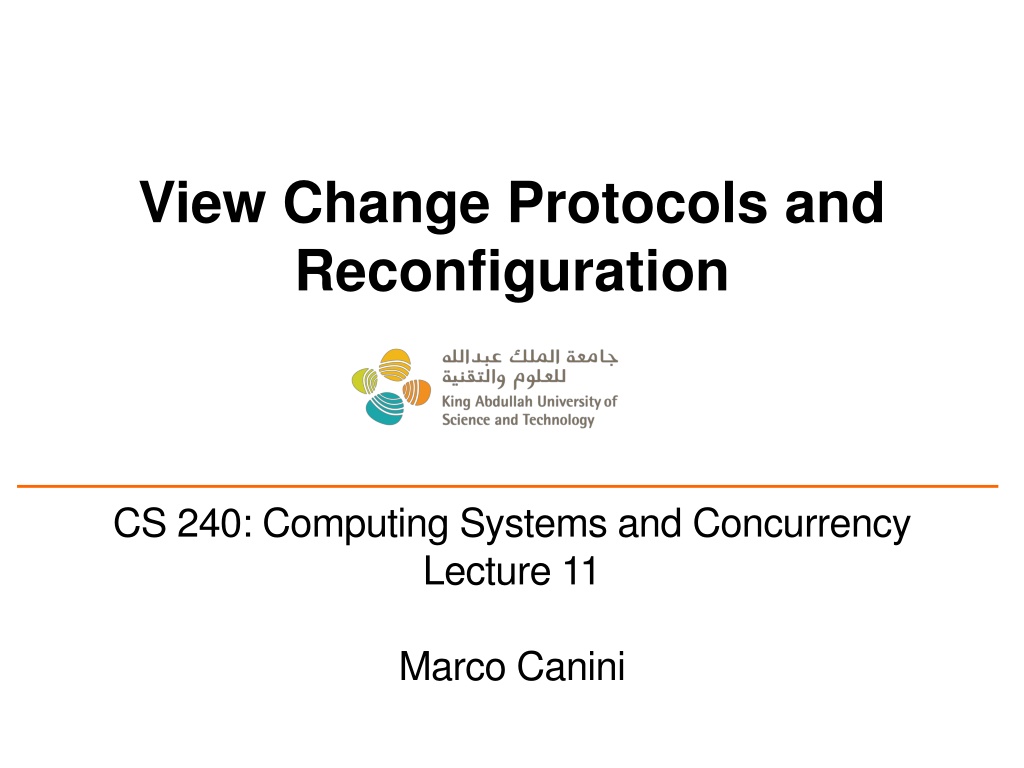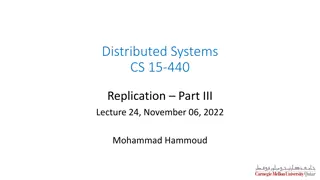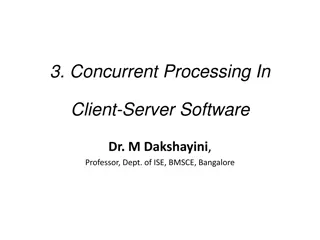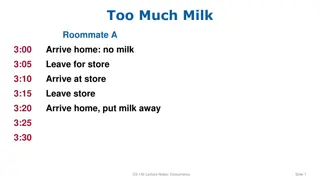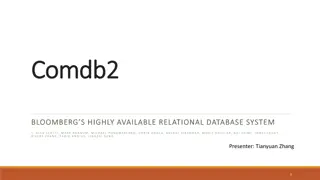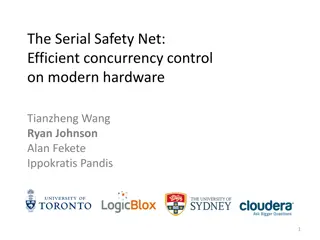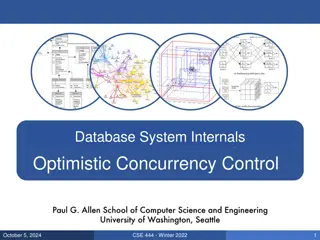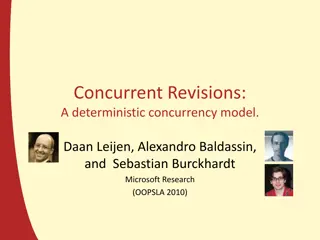Understanding Replica Management in Computing Systems and Concurrency
Introduction to replica management in computing systems and concurrency, covering primary-backup replication, transitioning from two to many replicas, and exploring Viewstamped Replication for increased fault tolerance and scalability. The concept of Replica state and Normal operation scenarios are also discussed.
Download Presentation

Please find below an Image/Link to download the presentation.
The content on the website is provided AS IS for your information and personal use only. It may not be sold, licensed, or shared on other websites without obtaining consent from the author. Download presentation by click this link. If you encounter any issues during the download, it is possible that the publisher has removed the file from their server.
E N D
Presentation Transcript
View Change Protocols and Reconfiguration CS 240: Computing Systems and Concurrency Lecture 11 Marco Canini
Today 1. More primary-backup replication 2. View changes 3. Reconfiguration 2
Review: primary-backup replication Nominate one replica primary Clients send all requests to primary Primary ordersclients requests Clients shl Logging Module State Machine Logging Module State Machine Servers Log Log add jmp mov shl add jmp mov shl 3
From two to many replicas Clients shl Logging Module State Machine Logging Module State Machine Logging Module State Machine Servers Log Log Log add jmp mov shl add jmp mov shl add jmp mov shl Primary-Backup with many replicas Primary waits for acknowledgement from all backups All updates to set of replicas needs to update shared disk (recall VM-FT) 4
What else can we do with more replicas? Viewstamped Replication: State Machine Replication for any number of replicas Replica group: Group of 2f + 1 replicas Protocol can tolerate f replica crashes Differences with primary-backup No shared disk (no reliable failure detection) Don t need to wait for all replicas to reply Need more replicas to handle f failures (2f+1 vs f+1) 5
With multiple replicas, dont need to wait for all Viewstamped Replication: State Machine Replication for any number of replicas Replica group: Group of 2f + 1 replicas Protocol can tolerate f replica crashes Assumptions: 1. Handles crash failures only: Replicas fail only by completely stopping 2. Unreliable network: Messages might be lost, duplicated, delayed, or delivered out-of-order 6
Replica state 1. configuration: identities of all 2f + 1 replicas 2. In-memory logwith clients requests in assigned order op1, args1 op2, args2 op3, args3 op4, args4 ... 7
Normal operation (f = 1) Reply Request Prepare PrepareOK Client Execute A (Primary) B C Time 1. Primary adds request to end of its log 2. Replicas add requests to their logs in primary s log order 3. Primary waits for fPrepareOKs request is committed Makes up-call to execute the operation 8
Normal operation: Key points (f = 1) Reply Request Prepare PrepareOK Client Execute A (Primary) B C Time Protocol guarantees state machine replication On execute, primary knows request in f+ 1 = 2 nodes logs Even if f = 1 then crash, 1 retains request in log 9
Piggybacked commits (f = 1) Reply Request Prepare PrepareOK Client +Commit previous Execute A (Primary) B C Commit Time Previous Request s commit piggybacked on current Prepare No client Request after a timeout period? Primary sends Commit message to all backup replicas 10
The need for a view change So far: Works for f failed backup replicas But what if the f failures include a failed primary? All clients requests go to the failed primary System halts despite merely f failures 11
Today 1. More primary-backup replication 2. View changes With Viewstamped Replication Using a View Server 3. Reconfiguration 12
Views Let different replicas assume role of primary over time System moves through a sequence of views View = (view number, primary id, backup id, ...) P View #3, #6, P View #1, #4, P View #2, #5, 13
View change protocol Backup replicas monitor primary If primary seems faulty (no Prepare/Commit): Backups execute the view change protocol to select new primary View changes execute automatically, rapidly Need to keep clients and replicas in sync: same local state of the current view Same local state at clients Same local state at replicas 14
Making the view change correct View changes happen locally at each replica Old primary executes requests in the old view, new primary executes requests in the new view Want to ensure state machine replication So correctness condition: Committed requests 1. Survive in the new view 2. Retain the same order in the new view 15
Replica state (for view change) 1. configuration:sorted identities of all 2f + 1 replicas 2. In-memory logwith clients requests in assigned order 3. view-number: identifies primary in configuration list 4. status:normal or in a view-change 16
View change protocol (f = 1) Start-View- Change Do-View- Change Start- View (!) ++view # B (New Primary) view # log log C Time 1. B notices A has failed, sends Start-View-Change 2. C replies Do-View-Change to new primary, with its log 3. B waits for f replies, then sends Start-View 4. On receipt of Start-View, C replays log, accepts new ops 17
View change protocol: Correctness (f = 1) Execute A (Old Primary) Start-View- Change Do-View- Change Start- View B (New Primary) view # log log C PrepareOK Time Executed request, previous view Old primary A must have received one or two PrepareOK replies for that request (why?) Request is in B s or C s log (or both): so it will survive into new view 18
Principle: Quorums (f = 1) et cetera... Any group of f + 1 replicas is called a quorum Quorum intersection property: Two quorums in 2f + 1 replicas must intersect at at least one replica 19
Applying the quorum principle Normal Operation: Quorum that processes one request: Q1 ...and 2nd request: Q2 Q1 Q2 has at least one replica Second request reads first request s effects 20
Applying the quorum principle View Change: Quorum processes previous (committed) request: Q1 ...and that processes Start-View-Change:Q2 Q1 Q2 has at least one replica View Change contains committed request 21
Split Brain (not all protocol messages shown) Request Request Client 1 Execute Execute A (Primary) Network partition Execute Execute B (New Primary) Start-View Start-VC C Request Request Client 2 What s undesirable about this sequence of events? Why won t this ever happen? What happens instead? 22
Today 1. More primary-backup replication 2. View changes With Viewstamped Replication Using a View Server 3. Reconfiguration 23
Would centralization simplify design? A single View Server could decide who is primary Clients and servers depend on view server Don t decide on their own (might not agree) Goal in designing the VS: Only one primary at a time for correct state machine replication 24
View Server protocol operation For now, assume VS never fails Each replica now periodically pings the VS VS declares replica dead if missed N pings in a row Considers replica alive after a single ping received Problem: Replica can be alive but because of network connectivity, be declared dead 25
View Server: Split Brain (1, S1, S2) S1 View Server S2 (1, S1, S2) (2, S2, ) (2, S2, ) Client 26
One possibility: S2 in old view (1, S1, S2) S1 View Server S2 (1, S1, S2) (2, S2, ) (1, S1, S2) (2, S2, ) (1, S1, S2) (2, S2, ) Client 27
Also possible: S2 in new view (1, S1, S2) S1 View Server S2 (1, S1, S2) (2, S2, ) (1, S1, S2) (2, S2, ) (2, S2, ) Client 28
Split Brain and view changes Take-away points: Split Brain problem can be avoided both: In a decentralized design (VR) With centralized control (VS) But protocol must be designed carefully so that replica state does not diverge 29
Today 1. More primary-backup replication 2. View changes 3. Reconfiguration 30
The need for reconfiguration What if we want to replace a faulty replica with a different machine? For example, one of the backups may fail What if we want to change the replica group size? Decommission a replica Add another replica (increase f, possibly) Protocol that handles these possibilities is called the reconfiguration protocol 31
Replica state (for reconfiguration) 1. configuration:sorted identities of all 2f + 1 replicas 2. In-memory logwith clients requests in assigned order 3. view-number: identifies primary in configuration list 4. status:normal or in a view-change 5. epoch-number:indexes configurations 32
Reconfiguration (1) (f = 1) Prepare PrepareOK Reconfiguration Client new-config A (Primary) B C (remove) D (add) Time Primary immediately stops accepting new requests 33
Reconfiguration (2) (f = 1) Reply Reconfiguration Client new-config PrepareOK A (Primary) Prepare, B C (remove) D (add) Time Primary immediately stops accepting new requests No up-callto RSM for executing this request 34
Reconfiguration (3) (f = 1) Reply Reconfiguration Client new-config StartEpoch PrepareOK A (Primary) Prepare, B Commit C (remove) D (add) Time Primary sends Commit messages to old replicas Primary sends StartEpoch message to new replica(s) 35
Reconfiguration in new group {A, B, D} Reply Reconfiguration EpochStarted Client new-config StartEpoch PrepareOK A (Primary) Prepare, B Commit C (remove) D (add) Time 1. Update state with new epoch-number 2. Fetch state from old replicas, update log 3. Send EpochStarted msgs to replicas being removed 36
Reconfiguration at replaced replicas {C} Reply Reconfiguration EpochStarted Client new-config StartEpoch PrepareOK A (Primary) Prepare, B Commit C (remove) D (add) Time 1. Respond to state transfer requests from others Waits until it receives f + 1 EpochStarted msgs, f is fault tolerance of new epoch Send StartEpoch messages to new replicas if they don t hear EpochStarted (not shown above) 2. 37
Shutting down old replicas If admin doesn t wait for reconfiguration to complete, may cause > f failures in old group Can t shut down replicas on receiving Reply at client Must ensure committed requests survive reconfiguration! Fix: A new type of request CheckEpoch reports the current epoch Goes thru normal request processing (no up-call) Return indicates reconfiguration is complete 38
VR: Take-away ideas Viewstamped Replication is a state machine replication protocol that tolerates f crash failures in a replica group of 2f + 1 replicas The protocol uses replicated state to provide persistence without any use of disk f + 1 replicas serve as a quorum that ensures correctness; in every step of the protocol there is at least one replica that knows about the request There s actually sub-protocols that operate to address distinct concerns (see next slide) 39
Whats useful when Backups fail or has network connectivity problems? Minority partitioned from primary? Quorums allow primary to continue Primary fails or has network connectivity problems? Majority partitioned from primary? Rapidly execute view change Replica permanently fails or is removed? Replica added? Administrator initiates reconfiguration protocol 40
